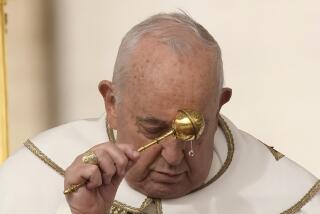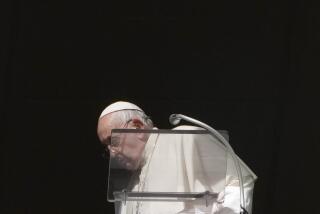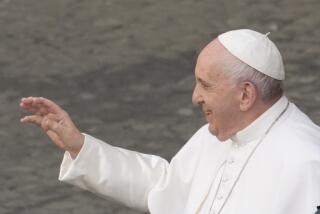Pope prays in visit to Turkish mosque
ISTANBUL, TURKEY — Shoeless and dressed simply in white, Benedict XVI became only the second pope in modern history to enter a mosque when he prayed Thursday alongside a senior cleric in Istanbul’s most majestic house of Islamic worship.
The pope toured the cavernous 17th century Blue Mosque with the grand mufti of Istanbul, gazing overhead at its intricate tile work, in his most deliberate and concrete gesture yet of conciliation toward Muslims infuriated by his comments.
“Thank you for this moment of prayer,” the pope told the mufti, Mustafa Cagrici. “This visit will help us find together the way to peace for the good of humanity.”
A stop at the mosque was added to the pope’s itinerary at the last minute after much debate inside the Vatican, where officials were seeking ways to calm Muslim rage over comments by the pope in September that linked Islam to violence.
In marked contrast to his predecessor, John Paul II, Benedict, as Cardinal Joseph Ratzinger, was reluctant to embrace interfaith celebration, making this gesture all the more remarkable. It came on the penultimate day of a busy pilgrimage to Turkey, Benedict’s first to a Muslim country, that also focused on bridging Roman Catholicism’s 1,000-year-old rift with Orthodox Christians.
He has had to balance concession to Turkey’s huge Muslim majority with support for the country’s dwindling and beleaguered Christian minority. Excessive overtures to one risk offending the other.
Dozens of Turks waving banners telling the pope to go home were arrested Thursday at small protest rallies scattered around the historic Sultanahmet district of Istanbul, where much of Benedict’s itinerary took him. Well-armed riot police were stationed throughout that and other parts of the city, much of which was virtually locked down in a massive deployment to ensure the pontiff’s safety.
Police beat some of the protesters, along with a number of journalists.
“The popes -- were they not the ones who tried to destroy Turks and Islam? Who organized the crusades?” demanded one protester, Aydan Perdahly, 37. “They should not give lessons of peace here.”
Nonreligious stop
The pope avoided potential controversy in a visit to the Hagia Sophia, an imposing structure built in the 6th century as a Byzantine church and converted to a mosque in the 15th century by Ottoman sultans. The rigidly secular forces that formed modern Turkey in the early 20th century turned the Hagia Sophia into a museum, one of Istanbul’s most popular tourist destinations where public displays of worship are banned.
The mere suggestion that the pope might pray there had enraged Turkish nationalists. When the late Pope Paul VI came to Istanbul in 1967, he knelt to pray in the Hagia Sophia, touching off protests by extremists who were convinced that he was trying to reassert Christian jurisdiction over the site.
Benedict visited the vast museum of domes and minarets, an incongruous combination of Muslim and Christian features, in more restrained fashion. He refrained from any overt religious gestures and instead listened to explanations from his host, Istanbul Governor Muammer Guler.
Benedict and his entourage then moved across the street to the Blue Mosque, officially named Sultan Ahmet Mosque for the ruler who commissioned its construction in 1609.
In deference to Muslim custom, Benedict removed his red-leather shoes and slid his feet into white slippers before walking into the building, illuminated dramatically by scores of lanterns suspended from the blue-tiled ceiling.
Cagrici, the mufti, led Benedict through the mosque, reaching the mihrab, or niche, that faces Mecca. There the two men paused in silent reverence. The pope folded his arms over his midsection, just below the large golden cross dangling from his neck, cast his eyes downward and, finally, bowed his head as the turbaned mufti standing at his side said a brief prayer.
The first pope to enter a mosque was John Paul II, who in 2001 prayed inside the 8th century Great Omayyad Mosque in Damascus, Syria, at a tomb believed to contain the head of John the Baptist. Fifteen years earlier, John Paul was also the first pope to enter a synagogue.
Vatican spokesman Father Federico Lombardi said the stop at the Blue Mosque was added to the pope’s itinerary as “a sign of respect.” He noted that a Christian believer can pray in a mosque and said the pope’s meditation was “personal and intimate.”
“With this visit to the mosque we have made significant steps forward,” Lombardi said, adding it would form the basis to launch a deeper dialogue.
Earlier Thursday, the pope engaged in a lengthy religious ceremony with the head of the world’s Orthodox Christians to mark the feast day of St. Andrew, the older brother of St. Peter. The two were the earliest evangelizers of the Christian faith after the death of Jesus.
A plea for unity
Alongside Ecumenical Patriarch Bartholomew I, the pope called for greater freedoms for Turkey’s non-Muslim religious minorities and unity between the ancient branches of Christianity.
“The divisions which exist among Christians are a scandal to the world and an obstacle to the proclamation of the Gospel,” the pope said.
Roman Catholics and Eastern Orthodox split in the 11th century over several issues, the foremost being the authority of the pope.
But Benedict and Bartholomew were keen to work beyond those differences, and in a joint declaration spoke of their shared interest in preserving the “Christian roots” of Europe.
Orthodox Christians hoped the presence of the pope would serve as a boost to their plight in Turkey, which includes onerous restrictions on property ownership and the training of clerics.
Special correspondent Duygu Guvenc in Istanbul contributed to this report.
More to Read
Sign up for Essential California
The most important California stories and recommendations in your inbox every morning.
You may occasionally receive promotional content from the Los Angeles Times.











